Hi everybody,
Summer is lingering this year, with October already here and temperatures still close to 30° Celsius. But we are not going to complain as we can take advantage of this nice weather to visit some places we try to avoid during the touristic season.

Bassin d’Arcachon – Le Teich Ornithological Park – Storks © 2011 Scotiana
We’ve spent hours following the sunny sandy paths which wind between land and water in the vast ornithological park of Le Teich, observing birds we’re not used to see in our gardens: cormorants, white and grey herons, storks, curlews, spoonbills, coots and so on…
We had taken with us a guide about birds to try to put a name on every beautiful creature we happened to meet there and I’ve tried to write each French name together with its English counterpart on my vocabulary notebook ;-). It can be helpful when we’ll go back to Scotland. We’ve seen so many birds there and some of them are still waiting to be given a name on our photos 😉
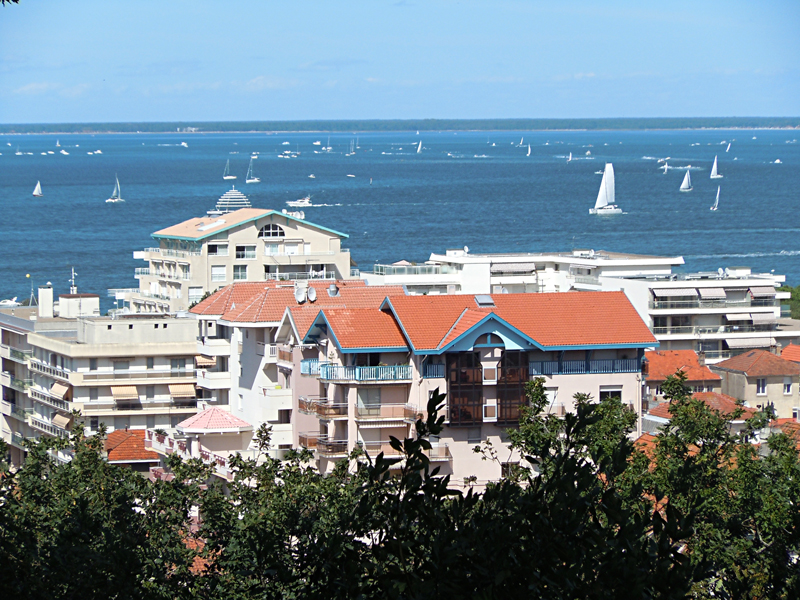
Arcachon ville d’été – View from the Belvédère in ville d’hiver © 2011 Scotiana
Determined to enjoy every day of this nice weather we also decided to revisit Arcachon from a new angle, this time venturing into its less known heights rather than following the seafront as we usually do. The town is divided into four parts named after the seasons: “ville de printemps”, “ville d’été”, “ville d’automne” and “ville d’hiver”.
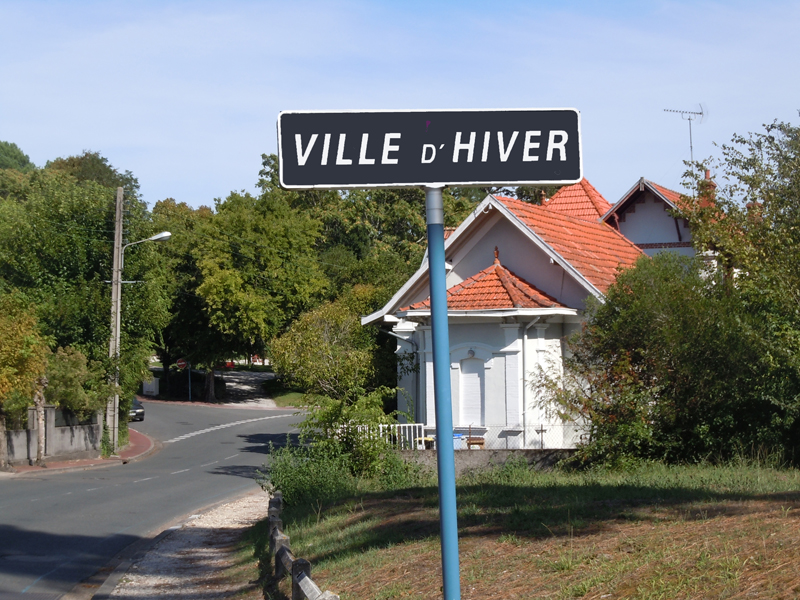
Arcachon ville d’hiver © 2011 Scotiana
Autour du bassin d’Arcachon, on a toujours aimé les paris fous. Comme celui de faire surgir en quelques années une ville au milieu des sables. Arcachon est né de quelques coups de génie. Celui de François Legallais, d’abord, qui décide de profiter de la vogue des bains de mer pour installer un hôtel en 1823 là où n’existaient que quelques cabanes de pêcheurs et une forêt de pins. Mais surtout celui des frères Emile et Isaac Pereire, banquiers actionnaires de la richissime Société des chemins de fer du Midi. Ils ont l’idée d’une ” ville d’hiver ” destinée à accueillir une riche clientèle à la saison froide. Ils achètent des terrains sur les hauteurs d’Arcachon, où les capitaux de leur entreprise permettent l’édification d’un quartier de villégiature. Chalets, villas exotiques, les propriétaires rivalisent de mégalomanie et d’extravagances dans les allées sinueuses.
(“Folies du Bassin d’Arcachon” – Sophie Pujas – Le Point 29-07-2010)
If the winter town is now less popular than the summer town it did have its hour of glory however and it has its charm too.
We did enjoy our walk along the quiet streets called “Allées”, trying to imagine what was hiding behing the evocative and colourful names of the villas, also climbing up (not me however!) the dangerous steps of the Belvédère which reminded me of the diabolic stair in the psychological horror film La maison du Diable (The Haunting – Robert Wise film – 1963)
When we decided to visit the Ville d’Hiver in Arcachon we had no idea that we would fall on a Scottish Trail there but it was deliberate anyway for I wanted to see one villa in particular: villa Térésa.
La maison, vaste comme une cathédrale, n’était pas la sienne. On la lui avait prêtée. C’était une folie de la Belle Epoque, classée monument historique comme toutes celles qui l’entouraient – une centaine de villas baroques quand elles n’étaient pas insensées. Avec un immense toit d’ardoises à bordures crénelées, des balcons à balustres et un porche d’entrée si large, si haut qu’il aurait pu accueillir toute une caravane, elle s’insérait dans un ensemble uniformément fin de siècle, telle la pièce d’un gigantesque puzzle. L’architecte qui l’avait dessinée, ennemi des formes simples, avait laissé libre cours à son imagination et abusé des ornements qui plaisaient sous Napoléon III. Des gargouilles, dignes de Notre-Dame de Paris, décoraient les gouttières.
(La Ville d’Hiver Dominique Bona Editions & Fasquelle 2005)
This villa, situated 4 Allée Rebsomen, which had been built in 1882 for an Irish painter is the setting of La Ville d’hiver, a very interesting novel by Dominique Bona which I had read some time before.
A peine le chemin de fer avait-il rendu la région plus aisément accessible que les frères Pereire firent apporter à Arcachon les matériaux utiles à la construction de la Ville d’Hiver – les pierres, les tuiles ou les ardoises, le marbre – ainsi que des tonnes de terre fertile pour créer des jardins d’agrément. Afin d’accueillir les futurs habitants, on avait commencé par édifier une gare… Dans son enceinte, les voyageurs se bousculaient avec meubles et bagages. Car la Ville d’Hiver, si déserte aujourd’hui, avait autrefois ressemblé à une ruche et l’on y débarquait des quatre coins du monde…
Face à la tuberculose qui tuait à petit feu, la Ville d’Hiver offrait un programme de choix. Tout y était pensé, organisé en fonction du terrible bacille : non seulement les rues sinueuses, pour déjouer les mauvais vents, non seulement les murs épais des maisons, leurs innombrables cheminées, pour tenir les malades bien au chaud, mais la forme même des pièces. Arrondies, sans angle mort, elles paraient à la formation des nids de poussière, où les médecins voyaient une des multiples agressions fatales aux poumons.
(La Ville d’Hiver Dominique Bona Editions & Fasquelle 2005)
In this book you learn a lot of very interesting local anecdotes about the Ville d’Hiver and its beautiful villas, also about Arcachon and its area.
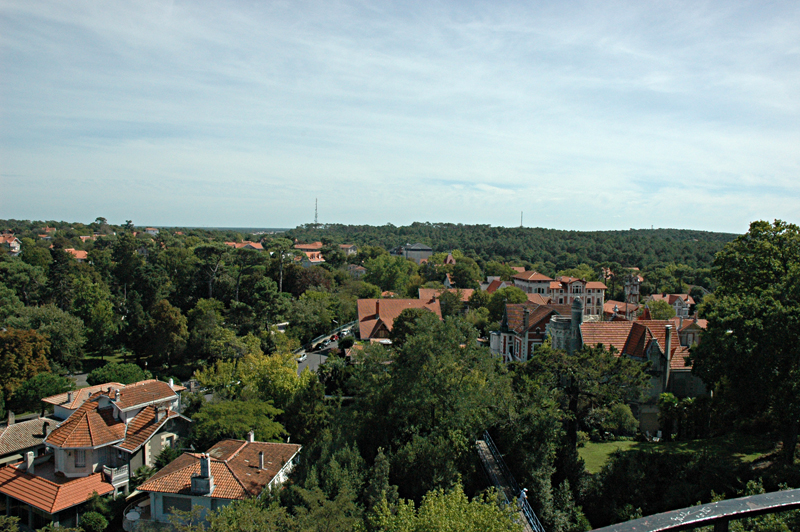
Arcachon ville d’hiver – View from the Belvédère © 2011 Scotiana
Though several of its beautiful and sometimes extravagant villas have been demolished to be replaced by modern buildings, this quiet and residential area shelters some of the most picturesque houses I ever saw, each of them wrapped in its mystery with many stories to tell!
But imagine our surprise when we fell upon a magnificent villa which, as we could read on a board, had been built for Laird Mac Gregor, a mysterious Scottish Lord. The house was named “Craigcrostan”, a name with Scottish connotations. This laird must have been a very wealthy man for not only did he buy a dune to have his house built on it but he also was at that time the happy owner of two nearby villas: “Eugénie” which he renamed “Glenstrae” (a Scottish name) and “Hermosa” which he renamed “Soleil Levant”.
At the end of the nineteenth century, thanks to the initiative of audacious local entrepreneurs who first decided to build a railway line and a station there and thanks also to a privileged environment (fine beach, mild climate and vivifying balmy air reputedly good for health, especially for people suffering from pulmonary diseases), Arcachon was gaining ground over the vast and wild forest of pine trees, oaks and shrubberies which had been planted on a boggy area. The place was then inhabited by a small community of fishers, shepherds and ‘résiniers’. At the end of the nineteenth century it quickly grew into a upper-class seaside resort and famous people used to come there from all over the world: writers (François Mauriac, Cocteau, Alexandre Dumas, Prosper Mérimée, George Sand, Gabriele d’Annunzio, painters (Toulouse-Lautrec, Manet, Dali…), musicians (Gounod, Debussy…) and even imperial or royal guests (Napoléon III, Alphonse XII of Spain, Sissi…).
“Il est difficile de se représenter ce que pouvaient être les paysages du bassin d’Arcachon avant que ne se développent la forêt et les stations balnéaires. Au début du XIXème siècle, d’immenses étendues marécageuses, couvertes d’ajoncs épineux, de bruyères et d’herbes folles, s’étalaient à perte de vue là où le pin maritime règne aujourd’hui sans partage. La côte de l’Océan inspirait aux voyageurs un effroi à la mesure de sa sinistre réputation. Les souvenirs de vaisseaux échoués, pillés par des naufrageurs, restaient dans toutes les mémoires. L’ensemencement du littoral commençait à peine, et les passes du Bassin, mal signalées, se perdaient dans le moutonnement à l’infini de dunes de sable nu où tout repère semblait impossible (le phare du Cap-Ferret ne sera construit qu’en 1840). Par gros temps, les navires en difficulté préféraient mettre à la cape au large, plutôt que tenter de se réfugier dans la baie. (Le Bassin d’Arcachon – A l’âge d’or des villas et des voiliers – Avant-propos – François et Françoise Cottin – Horizon Chimérique 2003)

Arcachon – Villa Craigcrostan © 2011 Scotiana
Du balcon, elle regardait le palmier et au loin, l’ombre violette des dunes. Tout autour, invisible dans la nuit, s’étendait la ville morte. En se penchant, elle aurait pu apercevoir la mer. Un petit bout de mer, entre le belvédère et les fûts sombres des cyprès. Mais elle ne bougeait pas. Incapable de détacher son regard du bel arbre à l’allure de gardien de phare, que la lune éclairait comme un projecteur, elle laissait le froid l’envahir. Le calme et le silence, si inhabituels à ses sens de citadine, l’enveloppaient entièrement. Un mouvement lui aurait paru offenser le paysage, troubler le mirage d’un bonheur parfait.L’air avait un parfum de citron ; il lui donnait envie de le boire.
(La Ville d’Hiver Dominique Bona Editions & Fasquelle 2005)
So, here we were, in Alley Faust, just in front of “Craigcrostan”, the beautiful neo-Palladian villa built in 1880 by a London architect for Laird Mac Gregor, a wealthy Scottish lord. The fact that he had renamed villa “Eugénie” into villa “Glenstrae”, after the name of a land occupied by the MacGregor clan in Scotland, shows how deeply attached he was to his Scottish roots. Why he did change “Hermosa'”, the name of his other villa, into “Soleil Levant” I don’t know, but what is sure is that from the “belvédère” (gazebo) of Craigcrostan he could admire the sun rising and setting on the beautiful Arcachon Bay.
Used to come there for health problems Laird MacGregor had finally settled in Arcachon. I’ve read that at that time there was an important English and Scottish community there. He was known as an eccentric man, never breaking his daily ritual ride in a horse car, beginning its trip snugly wrapped in a lot of blankets which he took off one after the other at defined ‘checkpoints’ where a servant was waiting for him to fetch the blankets back home.
The large estate looks onto Allée Faust, Allée Brémontier and Allée d’Espagne. The nice brick and stone façade of the house emerges from amidst a luxuriant vegetation with its two levels of columns and its large balconies ornamented with balustrades. With its composite style the house betrays at the same time colonial, Italian and Swiss influences (columns – wooden gazebo- roof with lambrequins). In 1882 the villa was painted in orange and pistachio. I’ve read that the elements of the interior design had all been created in England and that some of them have been preserved (a chimney figuring the twelve months of the year, glass-windows with the MacGregor coat of arms).
Maybe we’ll be given the opportunity to visit it one day though it must have been much easier to do so when Craigcrostan which had become successively the Lycée d’Arcachon and the Lycée Climatique was resounding with children’s cries .
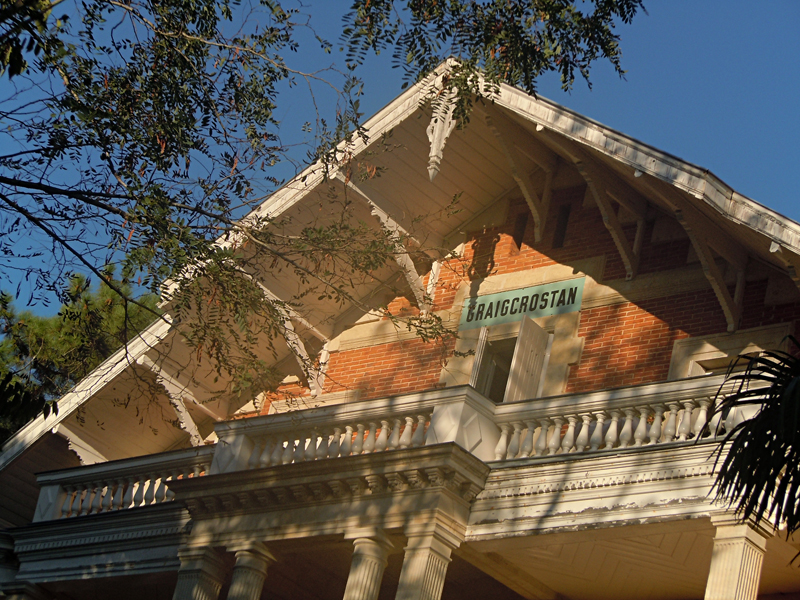
Arcachon villa Craigcrostan © 2011 Scotiana
I’ve looked into my Edward Dwelly Illustrated Gaelic-English Dictionary to try and find something about the name ‘Craigcrostan’. From what I’ve found there, I inferred that it meant ‘cliff of the puffins’.

A puffin on the island of Staffa, off Iona © 2006 Scotiana
Another Scottish reminiscence! I have never heard about the presence of puffins in France outside Brittany and we’ve been lucky enough to approach some of these friendly birds on the edge of the cliffs which stand on the tiny and magnificent island of Staffa, off Iona.
Last but not least I’ve read that Rob Roy Macgregor (1671 -1734) owned land at “Craigcrostan” in Scotland.
Just have a glance at this old postcard. Isn’t it fascinating to see what the house looked like at the time of Laird MacGregor… no palm trees then 🙂 and the architectural details are much more visible…
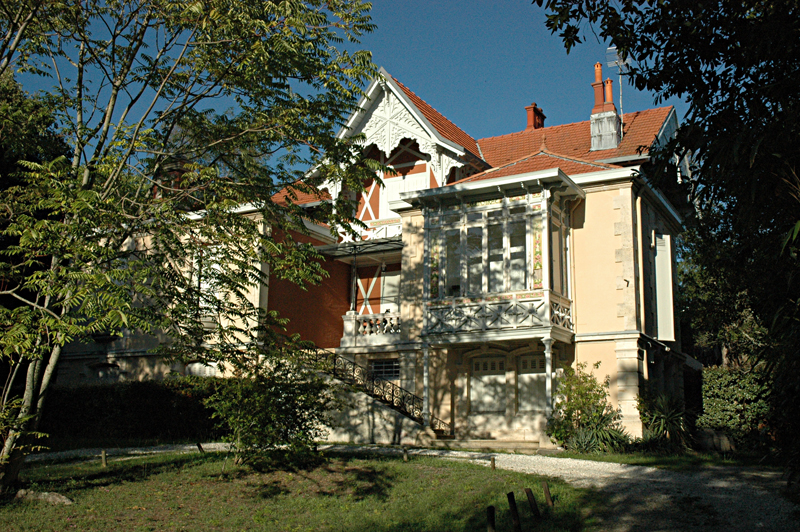
Arcachon Ville d’hiver – villa Glenstrae © 2011 Scotiana
Here’s Glenstrae… but we’ll have to come back in winter to try and take better photos. The whole town will smell of mimosa then and there will be no more leaves on the trees 😉
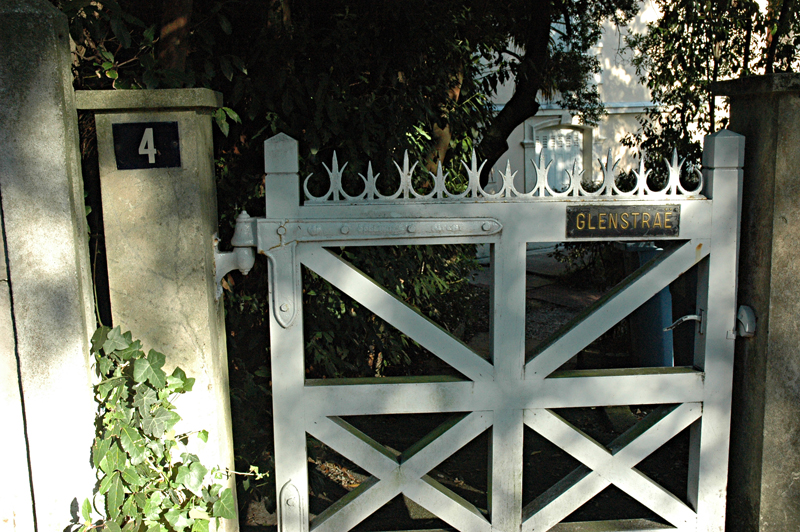
Arcachon Ville d’hiver – villa Glenstrae gate © 2011 Scotiana
How we would like to push the gate…
It did not change so much since Laird Mac Gregor times…

Arcachon Ville d’hiver – Villa Soleil Levant (Hermosa) © 2011 Scotiana
Not far from Craigcrostan and Glenstrae we fall upon “Soleil Levant” !
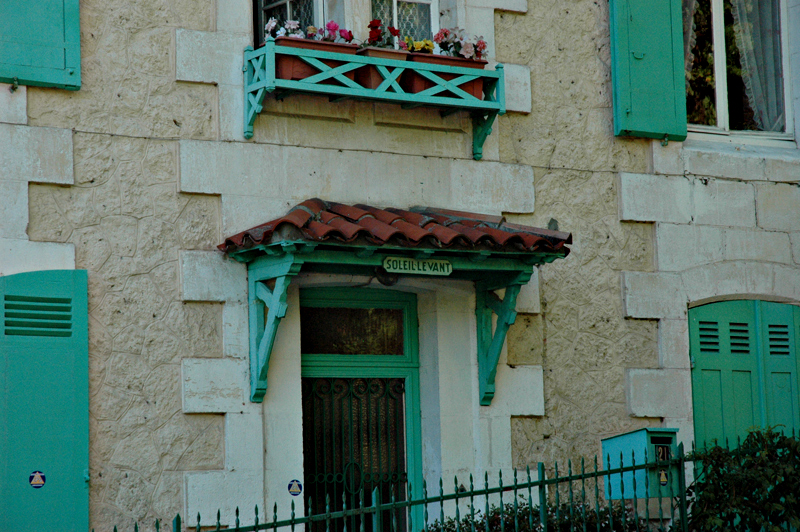
Arcachon Ville d’hiver – Villa Soleil Levant entrance door © 2011 Scotiana
Shall we knock at the door? A woman appears at the threshold and looked at us suspiciously as if we were planning a burglary… we should have introduced ourselves rather than fleeing like burglars…
Villa “Soleil Levant” looked like that in the olden times… it has not much changed either.
Just try to imagine how it was to live there in the olden times… when Laird MacGregor used to ride in his horse car every day. He must have passed here a number of times for the villa Craigcrostan is situated nearby.
This view has been taken from the garden of the Villa Glenstrae. Its gate with its typical cross comes from Scotland. On the right one can see the villa “Soleil Levant” with its gate open.
On this old postcard you can notice a man or woman riding a donkey and leading another one down Allée Brémontier. Like ‘chasse à courre’ donkey rides were popular leisure activities in the olden times, especially among the wealthy population of Ville d’Hiver.
Our summer walk in the Ville d’hiver had made me eager to know more about that Scottish Laird who owned three beautiful villas in Arcachon but I soon realized it would not be easy task as my first investigations led nowhere. Another case for Sherlock Holmes 😉 However, I ‘ve just discovered something quite interesting about this mysterious descendant of Rob Roy …
So, stay tuned if you want to know more 😉
Bonne lecture !
A bientôt. Mairiuna

Sunset on Bassin d’Arcachon © 2011 Scotiana












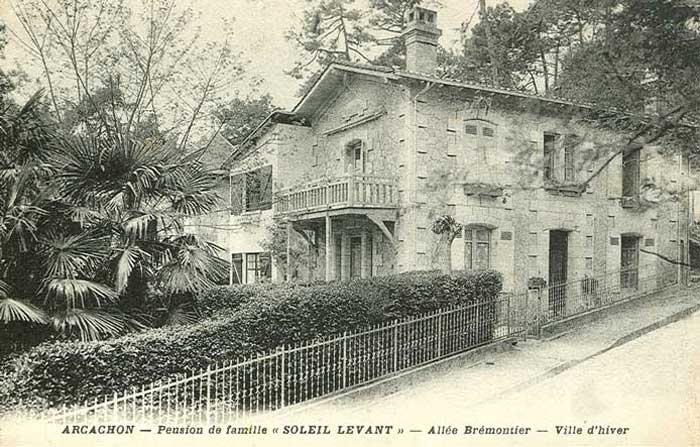


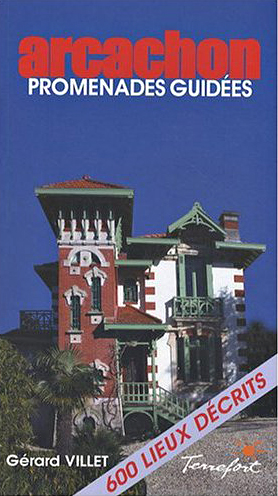
[…] family and owned three villas in Arcachon. You can read about him and his connection with Arcachon here and here. But he died a decade before 1902, so even if we can somehow turn ‘H.M.’ into […]
Many thanks Mr Lincoln for having aroused our curiosity about this mysterious inscription you’ve found on the wall of a tenement building in Edinburgh, not far from your home.Your investigations are worthy of Sherlock Holmes whose statue stands in Picardy Place to mark the birthplace of Conan Doyle in Edinburgh, in 1859 (a little digression too 😉
Yes the inscription “Heri solitudo, hodie vicus, cras civitas” which means in English ‘Yesterday a desert, today a village, tomorrow a city’and in French “Hier désert, aujourd’hui village, demain cité” is the motto of Arcachon. It was created by Alphonse Lamarque de Plaisance, the first mayor of the town when Napoléon III came to give the city its official “birth certificate” on 2 May 1857. I’ve found on Wikipedia a description of the area not long before the visit of the Emperor and it is quite in keeping with the old postcards I’ve seen of Arcachon. “It was just a forest of pine trees, oaks and strawberry trees (arbutus), with no road links, and home – mostly when the weather was expected to be warm, and more in wood huts than in real houses – to fewer than 400 people, mostly fishermen and peasants. In earlier years, when some hygienists began to recommend sea bathing, three sea establishments were laid out by some entrepreneurs especially for the Bordeaux bourgeoisie and other wealthy people. This was the beginning of a new lifestyle, and some of the locals got the opportunity to claim their independence from La Teste-de-Buch, which owned their properties, in order to found a “free” new town, Arcachon ”
Indeed, with so many sand dunes around, Arcachon must have look like a desert in the olden times but its motto has proved to be quite premonitoryfor Arcachon is no longer a desert, nor a village but a prosperous little town and a very popular holiday resort. Many people however complain that it looks like a desert “à la “saison morte”… though we prefer to visit the place in winter ;-). Normally Arcachon is situated only 40 minutes from our home but in summer it is much more …
Tell us if you find more information about this mysterious inscription and, in the meantime, I invite our readers to visit Mr Lincoln’s page and to discover “The Lincoln Project”, Fiona and Ewan’s very interesting blog.
Amitiés de toute l’équipe de Scotiana.
Mairiuna
Thanks Mairiuna, I’m glad you found my blog post interesting – as I did your investigation into William Laird Macgregor. I will certainly write more if I am able to uncover any more information about this mystery!
Hi,
I own the first floor flat at Villa Glenstrea and have been trying to trace some history for many years so this article is very interesting.
Regards
George
Il semble que Willima Laird Mac Gregor soit décédé à Bagnères-de-Bigorre (Hautes Pyrénées, France) ce on peut lire l’acte de décès suivant : « L’an mil huit cent quatre vingt onze et le dix sept juillet à neuf heures du matin en l’hôtel de la mairie de Bagnères (Hautes Pyrénées), devant nous Jean Marie Dejeanne, docteur en médecine, Maire de cette ville, officier public de l’Etat civil de ladite ville, ont comparu John Edward Morrison, rentier, âgé de quarante quatre ans et Jean Marie Dubaud, chef des bureaux, voisins du défunt et domiciliés à Bagnères de Bigorre ; lesquels nous ont déclaré que William Laird MacGregor, rentier, âgé de soixante quinze ans, domicilié à Arcachon, se trouvant actuellement à Bagnères, sans autre renseignement, est décédé aujourd’hui à huit heures du matin, dans l’hôtel Bon Pasteur, rue de l’Horloge, ainsi que nous nous en sommes assuré. »
Nul doute que c’est celui qui a construit la villa Craigcrostan. Mais je n’ai pas su le rattacher au célèbre Macgregor Laird (1808 – 9 January 1861) qui était un marchand écossais, pionnier du commerce sur le Niger en Afrique. Ce pourrait être deux frères.
[…] https://www.scotiana.com/a-mysterious-laird-mac-gregor-in-arcachon/ […]